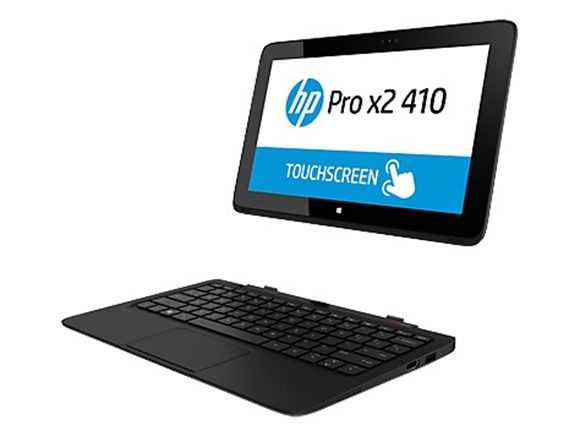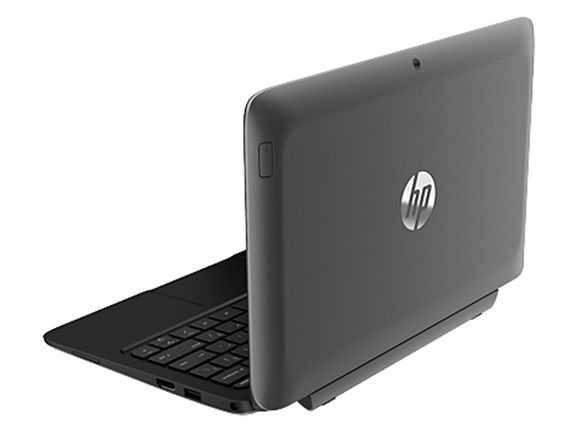I’m reviewing an 830 gram / 1.83 pound 11.6-inch Core i5 Windows tablet for Notebookcheck.net this week and after 24 hours I’ve got a good feeling for where this HP Pro X2 410 G1 is going. There are some really impressive specs and performance figures here but they’re sitting alongside some fundamental issues. One of those issues always will be an issue and it’s something that also affects the Surface Pro 3 that was launched this week.
Weight. The Pro X2 proves to me once again that large format tablets need to be exceptionally light to be truly useful. Yes, there are some of you out there that have a need for a powerful tablet and I accept that you’re happy with a trade-off, but there’s not many of you – especially when this has a 1366×768 screen, doesn’t lean back far enough in the dock to allow ‘lapping’ (because the tablet weighs too much and it would tip over) has no tablet stand and doesn’t have a digitizer layer. Total weight: 1.6KG.
The really sad thing about this design is that internally it’s looking very good indeed. I’ve just tested the SSD and seen some amazingly good speeds. The speakers are great, the backlight is strong, build quality is good, keyboard is great, there’s a total of 50Wh of battery and that Core i5 (4202Y) is running fanless. This is great electronic engineering. I’ve never had so much fanless PC power in my hand.
HP are pitching this into the business market but I’m struggling to see any major demand for it at the price they’re asking. Over $900 / 900 Euro for a Core i5 with 4GB and 128GB SSD. You can get more power, in less weight, with a recent Ultrabook. Go for a 256GB SSD option on the HP Pro X2 and the Surface Pro 3 looks like a much better option, especially as you get the digitizer and 8GB RAM.
I believe in 2-in-1s. I believe that one day the technology will allow us to build some amazingly light large format mobile screens that have the power of todays mainstream PCs. It might take a next-generation wireless display technology (WiGig is one to watch) or it might take a ‘screen as SoC’ technology to get things slimmed down but the modular approach seems like the sensible option. Right now the 11.6-inch screens are too big for workable 2-in-1s which means that 10-inches is the way to go right now. Truly table-top productive 2-in-1’s may take a few more years.
I’ll be continuing my HP Pro X2 410 G1 testing over the next week and you’ll probably see an overview on the YouTube channel in a day or two. Maybe the performance will win me over. Maybe I’ll find a hot-desk scenario that wins me over. Maybe that battery life (I’m expecting 8hrs of productivity) is the key. Maybe there’s enough in the laptop part (the keyboard sure feels good!) that the tablet part is just a bonus. Maybe the fanless aspect is good enough to make it unique for schools or some vertical that I can’t think of now! We’ll see over the next week but if you have any scenarios you think might work for this, let us know in the comments.
Thx Notebookcheck for allowing me some personal time with the HP Pro X2 410 G1. You can check out their reviews here.













How about the fact that the HP tablets are actually comfortable to hold in the hand whereas the Surface tablets feel thick with sharp edges and pointy corners?
1.8lbs is considered heavy for a Core i5 tablet? The Surface Pro 2 was only a 10″ tablet and weighed over 2lbs. It was also significantly thicker and required fans. The consumer versions of the 11″ HP X2 devices have been sold at far cheaper prices than the Surface Pro (not even including the keyboard). The bundled keyboard of the HP X2 devices with extra battery, 2 USB and HDMI ports is far better quality than the flimsy overpriced Surface keyboard cover.
With regards to “lapability” these are not the best devices for that kind of use. If you frequently find yourself leaning forward on a chair with a laptop on your laptop (not good for your sperm count BTW) then get a laptop. If you are like most people and use laptops on desks, tables, or sitting back on the couch then these devices work perfectly fine. Maybe journalists will never love this transformer design, but for most notebook PC users I think this is the ideal 2-in-1 form factor.
Funny you think 11″ 2-in-1 is too big, no doubt due to spending so much time with netbooks and 10.1″ tablets. My HP X2 is a 13.3″ model and I would love to have a compact 11″ version of it for portability. My brother has an 11″ Envy X2 which I envy for everything except specs. I can only imagine what you would say about the 13″ HP X2. In my opinion a 10″ screen is too small to be my main PC, but I could manage 11.6″ as my only PC/tablet.
Very interesting post, cool8man! Thanks.
Total Weight with keyboard. That’s exactly why I still think “Sliders” (or Sony Flip with screen side up) should be nice.
The “Detachables” needs extra weight in the keyboard, well… to Counter-weight.
With Sliders, relocate the Motherboard and battery under the keyboard and there is no need to counterweight. If the 12″ Surface Pro 3 tablet can weigh just 800gm, I’ll:
– swap the weight of the kick-stand to get a slider hinge/rail instead (+0gm)
– add in keyboard & touchpad electronic components (+80gm)
– add a second full USB port (+10gm)
– Less casing & strucutral material behind the screen because the heavy components has been relocated to the base (-20gm)
– Extra casing & structural material for the base (+80gm)
– Combined thickness will be slighly thicker, but if they resist the urge to pack more things in, the extra empty space can improve thermals, or they could make the battery replaceable, or perhaps leave a silo for the digitiser. (+0gm)
That will net a ~950gm 12″ slider, right now. It’s comparable with the Type-cover solution in weight, and perhaps even better in terms of ergonomics. Another year or so, the whole thing will be close to 850gm.
That kind of weight is much more attractive for people who need to have a keyboard handy (ie. most Win8 audience); It has no tipping problems, perfectly lappable, and no need to juggle with detaching/attaching the 2 peices when start/finish using (minor hassles like this DETERMINES how often you’ll take out the device from your bag). Depending on the hinge design (such as Sony Flip), it may even allow adjustable screen angles and not sacrifice much trackpad space.
That sounds really nice, except the designs out there are far heavier. The best I’ve seen is the LG Tabbook 2, with the Core version weighing 1.05kg. And it costs helluva lot, with the base model in the $1400 range. If they want to make it any lighter, they would have to use Carbon Fiber, which may raise it to $2000.
In contrast, Clamshell Notebooks are far lighter. The lightest was the NEC LaVie Z at 875 grams.
Reality and theory is LOT different.
I find really interessant this laptop for the big batteries and for the i5 fanless. The weight is not a problem for my opinion, becuase usually it will be used like laptop and not like a tablet. But there is an other big question that needs to be treated about the 410 G1: from some unofficial voices it seems that the screen digitizer of this item is compatible with the Atmel second generation pen! Is true, because if it is so his value changes very? Has someone probe this? Are there underlying agreements that do not allow advertising for the pen?